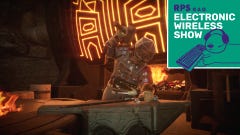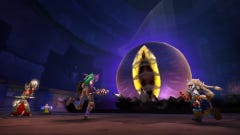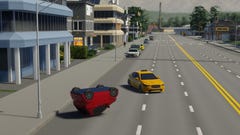Starfield's exploration looks like searching a quarry for the best piece of gravel
Freedom, but freedom to what?
"So why go this big with Starfield?" asks Bethesda Softworks' lead landscape artist Matt Carofano at the beginning of a segment in tonight's Starfield Direct. "Because we want to give you freedom on a galactic level," is the unsatisfying response.
Starfield features over 1000 planets to visit, each procedurally generated upon your approach but populated with handcrafted elements. Your "freedom" upon landing on these planets - many of which seem near-barren - is whether you spend your time doing some quests, 'surveying' the local flora and fauna, or shooting rocks with your space laser.
The quote above is from the Starfield Direct segment on exploration, which begins at 32 minutes and 49 seconds.
No Man's Sky is the obvious point of comparison in everything that's shown during this segment. That includes the heavy emphasis on the tech underpinning Starfield's galactic simulation, in which the planets, moons and stars you can see in the sky above you are all fully simulated celestial bodies that can be visited with your spaceship.
But it extends to the planets themselves and your activities on them. Starfield's droop-beaked dinosaurs, flap-mouthed pipe beasts, and skew-whiff crabs and scorpions are all handcrafted, not procedural, but they still look like the sort of creatures No Man's Sky might have generated. Your interactions with the local fauna also include scanning them to collect XP-bestowing data about them, with extra bonuses should you successfully survey an entire planet or star system, just like in Hello Games' space survival 'em up. I'm not sure the freedom to do this is meaningful.
Starfield remains a Bethesda RPG, of course, so there are quests, too. Lead technical producer Jean-Francois Levesque explains that they "generate the planet itself as a procedural content, but the hand-crafted content itself comes as the player explores." That means that planets are constructed as "a block of terrain", and then populated with "interesting locations for the player to explore, creatures to encounter, ore and plants to pick up." Wherever you land on a planet, then, the game can presumably make sure you're near to one of the quests available on planet's of that type.
In the video above, that quest is found at a science outpost where a scientist tells you that "aggressive creatures have been disrupting our experiments." Their habitat is nearby. It seems like a straight forward "go to a cave, kill 5 space [whatevers]" deal. Bethesda have traditionally been good, in Elder Scrolls games at least, at subverting those sorts of quests with interesting story twists. We never see enough of any single quest to know if that's the case here. Levesque does say that their planetary generation system "allows us to add that touch of environmental storytelling that Bethesda is known for", but then he says this over a shot of a skeleton lying, ignored, in the middle of a base.
What is clearer is that Starfield has, as one developer puts it, "both the exciting planets and the quiet ones." The quiet ones seem to be planets with only rocks and dust for miles around. Presumably you can shoot those rocks with your space laser to gather materials for fuel or trade, but, well, they don't seem exciting.
I was recently playing masocore climbing game Getting Over It, and during its narration game designer Bennett Foddy talks about how people often think games will "soon be made out of prefabricated objects, bought in a store and assembled into a world." Foddy disagrees. He instead argues that those prefabricated objects are "trash", not because they're badly made, but because "they're trash in the way that food becomes trash as soon as you put it in the sink."
"Things are made to be consumed and used in a certain context, and once the moment is gone they transform into garbage. In the context of technology those moments pass by in seconds."
This is how I feel about Starfield's galaxy. The parts from which it is assembled - high-fidelity planets, carefully crafted alien creatures, surprising quests - were not bought in a store and they may prove to be well made. But since they're pieced together procedurally and stretched across 1000 planets, it feels to me as if they have been removed from any any "certain context." I'm not excited at the thought of exploring 1000 planets to find the exciting ones, I'm exhausted.
NotE3 and Summer Game Fest 2023 is over for another year. You can find out all the latest news by visiting our E3 2023 hub, or you can catch up with our round-up posts of everything that was announced at Summer Game Fest, the Xbox Games Showcase, the PC Gaming Show, Day Of The Devs, and our top highlights from the Wholesome Direct.


















